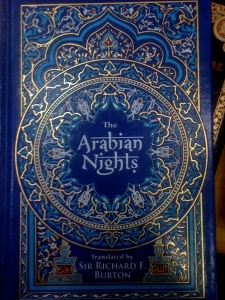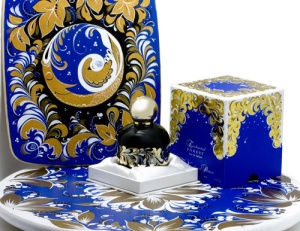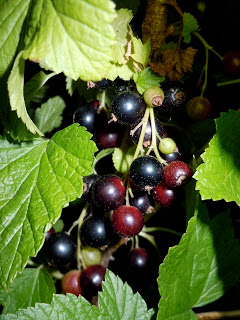The royal perfume house of Amouage would be perfect for a fairy tale or Greek myth. It would be the story of King Midas, and all he touched would be perfume gold. It would  have Ali Baba and a cave filled with treasures of scent and spice, incense and frankincense — not stolen by thieves but given freely by the Sultan with the order to create the most luxurious scent in all the land. Or, it would be the story of “Perfume” without serial killers and death, and with a happy ending.
have Ali Baba and a cave filled with treasures of scent and spice, incense and frankincense — not stolen by thieves but given freely by the Sultan with the order to create the most luxurious scent in all the land. Or, it would be the story of “Perfume” without serial killers and death, and with a happy ending.
As the renowned perfume critic, Luca Turin, said in a 2007 German magazine article:
The story of Amouage is remarkable. Twenty five years ago an Omani prince decided that his country, renowned since Egyptian times for the quality of its frankincense, home to the unique Green Mountain rose and on whose beaches half the world’s ambergris lands at random, needed a perfume firm that would take on the world’s greatest.
So, in 1983, His Highness Sayyid Hamad bin Hamoud al bu Said was ordered to do just that by His Majesty Sultan Qaboos bin Said, the ruler of the Sultanate of Oman. As the perfume store Aedes explains, they wanted “to tell the world about the ingredients particularly found in Oman – the rarest frankincense from Dhofar in the south of the country and the rarest rose of all, the rock rose harvested high up in the mountains of the Jebel Akhdar range towering over the Sultanate’s beautiful capital, Muscat.”

A Thousand and One Nights.
Consequently, Amouage tends to use very Middle Eastern ingredients such as oud or agarwood, rose, incense, resins like labdanum, and spices. It also hires some of the most famous “noses” in the perfume world to create its fragrances, supposedly with an unlimited budget. No expense spared. And the result is some of the most expensive perfumes in the world, even if no longer the most expensive. (It amuses me that the Amouage website describes its offerings as “The Gift of Kings” because it truly means that – both literally and figuratively.)

The Sultan of Oman with Queen Beatrix of the Netherlands in Oman.
On its 25th anniversary in 2007, Amouage launched two celebratory eau de parfums  under the guidance of its artistic director, Christopher Chong, and created by the famous orientalist nose, Bertrand Duchaufour. (“Orientalist” is Luca Turin’s description, not mine.) The men’s version was called Jubilation XXV and the women’s version was Jubilation 25. Both versions are eau de parfum concentration and both are essentially considered to be unisex fragrances. Certainly both genders seem to wear the different versions. I have both and plan to review Jubilation 25 tomorrow. For now, let’s focus on the men’s version.
under the guidance of its artistic director, Christopher Chong, and created by the famous orientalist nose, Bertrand Duchaufour. (“Orientalist” is Luca Turin’s description, not mine.) The men’s version was called Jubilation XXV and the women’s version was Jubilation 25. Both versions are eau de parfum concentration and both are essentially considered to be unisex fragrances. Certainly both genders seem to wear the different versions. I have both and plan to review Jubilation 25 tomorrow. For now, let’s focus on the men’s version.
Jubilation XXV is classified as an “Oriental Fougère” fragrance for men, which essentially means its a woody, aromatic oriental. (See the Glossary for a full explanation of the Fougère family of fragrances.) Fragrantica lists the notes as follows:
Top notes are orange, coriander, labdanum, tarragon, olibanum and blackberry;
middle notes are guaiac wood, cinnamon, bay leaf, honey, orchid, rose, clove and celery seeds;
base notes are opoponax, patchouli, myrrh, cedar, musk, oakmoss, ambergris, agarwood (oud) and immortelle.
Amouage describes the perfume’s evolution as follows:
With the grandeur of a great epic, Jubilation XXV opens majestically with notes of the finest frankincense from Oman.
At its heart are elegant notes of rose, orchid and smoky gaiac wood, evoking the philosophy of the enigmatic man carrying the essence of his sophistication across all eras and cultures.
Like the magic of a spellbinding epiphany, notes of musk, myrrh, cedarwood, ambegris, patchouli and immortelle resonate in the depth of the fragrance expressing his longing to travel far, across all continents, to find the ethereal unknown.

Jubilation XXV.
I don’t see it. Jubilation XXV opens with a massive bear hug of oud, concentrated honey, sweet myrrh, a touch of saffron, an almost imperceptible whisper of blackberry, and a strongly boozy amber accord — all under the strong auspices of balsam-heavy orange amber. It is incredibly reminiscent of Hermès’ Elixir de Merveilles, a fragrance I truly adore and which I reviewed here. It is all bitter Seville oranges which, just like in the Elixir, are wrapped in bitter black chocolate (compliments of the patchouli), salt, amber and woody balsam. I find barely any of the supposedly massive blackberry accord that a vast majority of the people have noted. There is a miniscule hint of it seconds into Jubilation’s opening, but it is mere seconds for me. The real fruit that I smell is, as noted, orange.
I was so astonished by the similarities that I tested it out a second time, late in the evening, with a different perfume on each arm. The only difference between the two openings is the touch of oud but — bar that — they were essentially identical. I’m extremely surprised that no-one else has noticed, but I suspect that most men don’t realise the Elixir is really unisex, and perhaps the average Elixir woman isn’t likely to try a seemingly “men’s” oud fragrance.
The oud note is extremely interesting in Jubilation’s opening hour. It is a fleeting, flickering thing; a darting ghost that pops up unexpectedly for a little while before vanishing from sight. Numerous commentators have said that Jubilation is a ghost as a whole: one minute it’s here, the next it’s gone, then it’s back again. They say the scent keeps disappearing, before reappearing. I haven’t had that experience with Jubilation as a whole, but I have had it with the oud element. Sometimes, it feels as though there is absolutely no oud in Jubilation and that I somehow accidentally sprayed on my Elixir. At other times, it appears with an almost mentholated note that cools down and cuts through the narcotic headiness of the warm, boozy resins, the rich heavy balsam-infused orange, and the peppery, smoky frankincense.
The oud in Jubilation is not the sharply screechy, metallic clang of the very synthetic-smelling Montale Aouds that I’ve tried. Nor is it the more medicinal oud of YSL‘s M7. It is slightly closer to the softer ouds in the By Killian Arabian Nights collection (though, at this early stage, not to Kilian’s Pure Oud). No, the oud in Jubilation is too tamed and softened by the smoky resins and the balsam-infused orange. That’s not necessarily a bad thing; it merely means that Jubilation’s first stage is not oud-dominant. (That comes later.)
Nonetheless, as a whole, Jubilation lacks the edge and hardness of some oud perfumes. It certainly lacks the more extreme aspect of oud scents like M7 (in its original formulation) which have resulted in descriptions like “dangerous.” Jubilation is a complex, nuanced, layered, very high quality and extremely expensive, rich scent. But it’s not dangerous, if that is what you’re looking for. And, dammit, it smells a lot like an oud version of Hermès Elixir for the first hour! It even has the latter’s unusual salty quality; a hint of the sea air mixed with saltwater taffy.
I checked to see how many of the same ingredients they share; both perfumes have cedar, orange, patchouli, resins, ambergris and incense. Jubilation has a ton more notes than the Elixir, but many of those separate notes come very close to replicating the accords in the Elixir. The myrrh, opoponax (sweet myrrh), labdanum (resin), olbanum (frankincense) and immortelle all have sweet, smoky, incense-y notes that parallel the Elixir’s patchouli, Siam resin, caramel, sandalwood, tonka bean and incense. Immortelle, in particular, has a maple-syrup, honey, caramel aspect that is definitely echoed in the Elixir. (See the Glossary for more details and definitions of these various notes and perfume ingredients.)
The real differences between the two scents begin after the first hour. Jubilation start to lose that sweet head, and the full roar of the woods start to appear. The lingering and final traces of orange are mentholated now, not caramelized. There is also far greater smoke. I smell hints of the Guaiac wood whose scent is described by Fragrantica as “smoky, tarmac notes” and which one Basenotes commentator finds to have a “rosy, honeyed-sweet and slightly smoky and waxy-oily slightly rubbery aroma. The Guaiac wood is subtle, especially under the much more overpowering oud notes, but it’s there. I don’t smell the coriander, orchid, bay leaf, tarragon or celery seeds listed in the notes. I cook extensively, and I know what all those herbs smell like. And they’re not appearing on me.
After a few hours, Jubilation turns into an intimate frankincense and oud party. The oud is much, much stronger now. It’s as though the top notes had muzzled it but now, it’s free to soar. The smell evokes a wintery outdoors, a large stone campfire among the dark, dry woods, with a brisk, chill in the air and the smell of burning leaves. There is stone-like coldness, with sharp black pepper and a definitely leather undercurrent to this oud. As such, it is very reminiscent of By Kilian’s Pure Oud. There is also that rubbery, almost plastic-y but medicinal aspect to the oud that calls to mind the pink plastic sides of a bandaid. That part evokes YSL’s M7. I wonder at times how much of this is the oud and how much is the Guaiac wood with its tarmac, rubber, pepper and smoke notes that others have found. Perhaps it really is just the oud itself combined with the incense, smoke, and biting pepper of the frankincense.
It doesn’t matter. The final result is that the two overarching smells alternate between a gentle waltz, an intimately fiery tango, and a loud cha-cha-cha. They weave in and out of the room. Sometimes, they are snuggling in the dark shadows of the alcoves – just out of sight. At other times, they tango back into the room and the rat-a-tat-tat of their heels stomp up my arm and to my nose. Then they vanish again. It’s bewildering. If I hadn’t read all those comments about the perfume’s on-again, off-again vanishing act, I would think I was hallucinating or that my nose had gone wonky.
The ghost act makes it hard for me to assess the sillage of Jubilation. Its projection for the first hour is as big as everyone says, but then it becomes much more difficult to ascertain. More than one person has wondered if Jubilation was just so strong at the start that their nose “got used to it” for large stretches of time. I will say that, on me, Jubilation does not have the massive longevity that most report — but that is hardly anything new. All in all, Jubilation lasted about 5.5 hours on me, with the last 3 being close to the skin.
All in all, I liked Jubilation XXV, but I’m hardly tempted to share in the mass genuflection and obeisance for the fragrance. Much of the adoring, worshipful praise seems — to me — to stem from those lovely opening notes that some have compared to spices and dates (the fruit) in a Turkish bazaar. Believe me, I know how utterly divine those notes can be; I raved about them extensively for Hermès’ Elixir de Merveilles. I suspect the Elixir is precisely why I’m not more overwhelmed and passionate about Jubilation; I’ve already had the experience. But, for one who hasn’t and who is seeking an oud fragrance on top of it, then I suspect Jubilation XXV will make you rather weak at the knees. It is not an overwhelming, crushing oud fragrance but a very luxurious one that feels expensive. Which is just as well, given that it is expensive.
Bloody expensive, in fact! The usual bottle is 3.4 fl.oz/100 ml and costs $290, £170.00 or around €210. There is a smaller 1.7 oz/50 ml version that costs £140.00, but a cursory review of a few US websites shows it is not available on any of the usual or big perfume sites. I found the smaller size only at Beauty Encounter where it retails for $245. It’s not a particularly good deal, given that double the quantity (or 3.4 oz) costs only $50 more. (As a side note, the women’s version of Jubilation is slightly more expensive in general: $300 for 3.4 oz, instead of $290.)

Amouage Gold in actual gold.
So, is Jubilation XXV worth getting? As always, that is a subjective and personal decision, but the cost of Jubilation makes it a bit more complicated than that equation usually is. Amouage may no longer make the most expensive perfume in the world — that was Gold in 1983 — but it’s still not a walk in the park. Yet, for a large number of people, Jubilation XXV is a scent without compare, one of their all-time favorites, and completely worth every golden penny. I would suggest testing it out via a sample. If it steals your heart, wonderful. If not, then perhaps you can always layer one of your existing ouds (particularly if you already own one from By Kilian) with the significantly cheaper, but always marvelous, Elixir de Merveilles.









